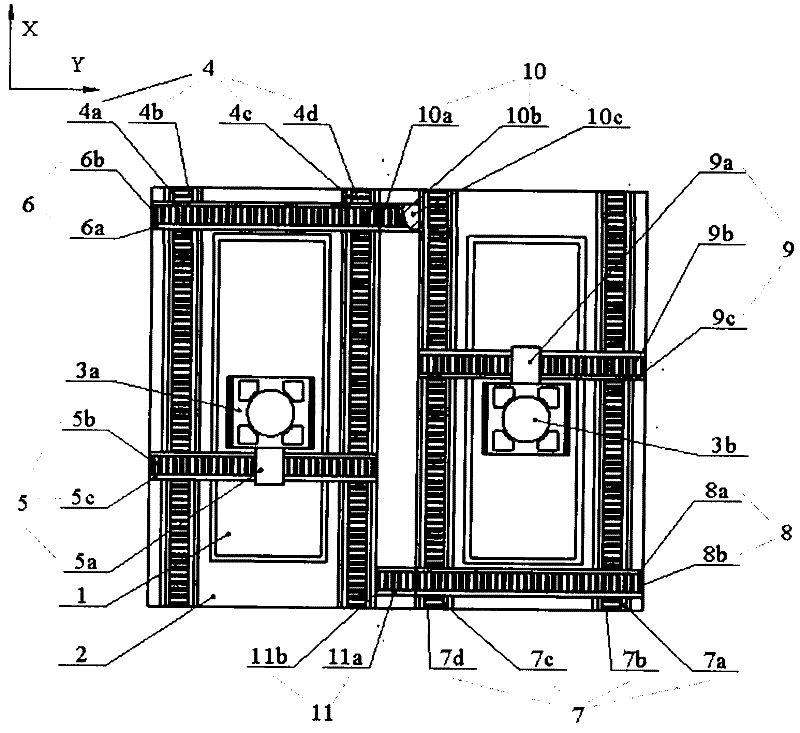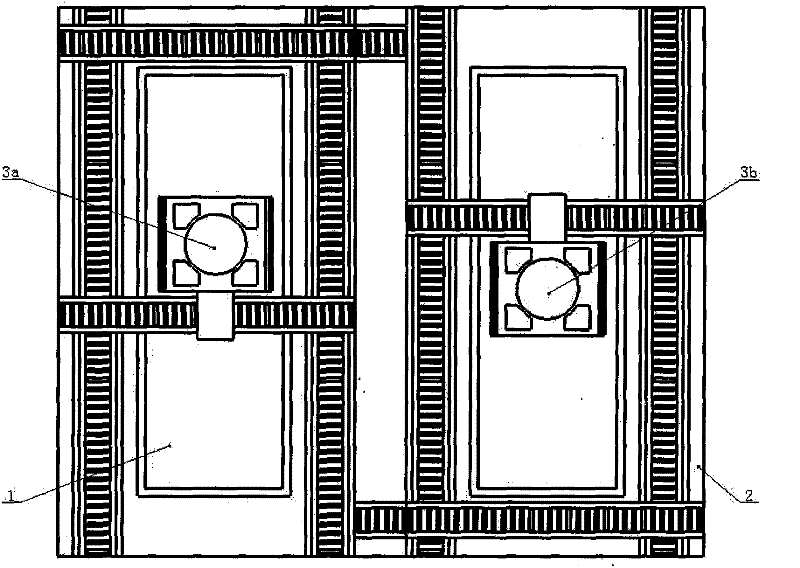Double work-piece stage exchanging device based on single/double drive stepping scanning, and method thereof
A step-and-scan, double-workpiece technology, applied in photoplate-making process exposure devices, semiconductor/solid-state device manufacturing, electrical components, etc., can solve the problems of large reaction force of the base, increase the time for changing the stage, and affect the dynamic performance of the system. , to achieve the effect of fast driving speed, small mass and inertia
- Summary
- Abstract
- Description
- Claims
- Application Information
AI Technical Summary
Problems solved by technology
Method used
Image
Examples
Embodiment 1
[0026] A dual workpiece stage exchange device based on single / dual drive step scanning. The system includes a base 1, a first wafer stage 3a set on the base 1 and running at a pre-alignment station, and an exposure tool The second silicon wafer stage 3b is arranged along the base 1 pre-aligned with the first static pressure air bearing guide rail 4a, the first linear motor stator 4b in the X direction, and the first linear motor moving in the X direction. Sub 4e, X-direction second static pressure air bearing guide 4c, X-direction second linear motor stator 4d, X-direction second linear motor mover 4f constituted X-direction first linear motion unit 4, X-direction first linear The moving unit 4 is provided with a Y-direction first linear motion unit 5 composed of a Y-direction first linear motor mover 5a, a Y-direction first linear motor stator 5b, and a Y-direction first static pressure air bearing guide 5c. The Y-direction second linear motion unit 6 is composed of the Y-dire...
Embodiment 2
[0034] It can be implemented by removing the X-direction second linear motor 4d, X-direction fourth linear motor 7d, Y-direction first transition linear motion unit 10 and Y-direction second linear motion unit 11 in the X-direction linear drive unit in Embodiment 1. Example 2, such as Figure 7 Shown. The process of exchanging the positions of the two workpiece tables in Embodiment 2 is exactly the same as in Embodiment 1. The difference is that the X-direction drive form of the two workpiece tables is dual-rail single-motor drive. Compared with Embodiment 1, the problem of inconsistency in X-direction dual-motor drive can be eliminated under the premise of ensuring the X-direction motion angular stiffness. At the same time, due to the omission of the transitional linear motion unit, the range of motion of the double-workpiece table can be increased, but the X-direction linear motor size is increased due to the X-direction driving force.
Embodiment 3
[0036] Remove the X-direction second linear motor 4d in the X-direction linear drive unit in Embodiment 1, the X-direction second static pressure air bearing guide 4c, the X-direction fourth linear motor 7d, the X-direction fourth static pressure air bearing guide, The Y-to-first transition linear motion unit 10 and the Y-to second linear motion unit 11 can obtain Embodiment 3, as Figure 8 Shown. The process of exchanging the positions of the two workpiece tables in Embodiment 3 is exactly the same as in Embodiment 1. Compared with Embodiment 1, Embodiment 2 reduces the X-direction linear drive unit in the X-direction second linear motor 4d, X-direction second static pressure air bearing guide 4c, X-direction fourth linear motor 7d, X-direction first The four static pressure air-floating guides, the Y-to-first transition linear motion unit 10 and the Y-to second linear motion unit 11 can also realize the station exchange of the two workpiece tables, but because the X-direction...
PUM
 Login to View More
Login to View More Abstract
Description
Claims
Application Information
 Login to View More
Login to View More - R&D
- Intellectual Property
- Life Sciences
- Materials
- Tech Scout
- Unparalleled Data Quality
- Higher Quality Content
- 60% Fewer Hallucinations
Browse by: Latest US Patents, China's latest patents, Technical Efficacy Thesaurus, Application Domain, Technology Topic, Popular Technical Reports.
© 2025 PatSnap. All rights reserved.Legal|Privacy policy|Modern Slavery Act Transparency Statement|Sitemap|About US| Contact US: help@patsnap.com



